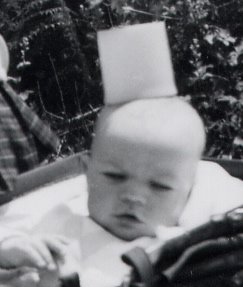
As we left the
Bank Street Lodge at 0600 next morning, cloud cover signalled a return of normal Scottish weather. But the forecast was reasonably good, so we had no real inkling of what was in store.
Near the end of a longer walk-in, of just over 2 hours, slowly the huge "Meggy" crags loomed up out of the mist and cloud. As we geared up in the shelter of boulders another team passed us, heading toward the easy gully leading to the base of Smith's Gully, our chosen objective. Nick threw his gear on and set off in pursuit, eventually overtaking the pair who confirmed they'd been intent on the same climb. They decided to do another route rather than follow us up Smith's and risk being hit by the falling ice we dislodged.
The route felt more serious and committing than anything we'd done on the trip so far: for one thing, at V, 5 Smith's Gully is one of the harder Scottish gully routes. The wind, cloud and spindrift snow blowing in our faces certainly added to the atmosphere in this remote and wild place.
The climbing was continuously varied and interesting for 3 long pitches. I led the 2nd, eventually belaying with ice screws at the very end of the 60m ropes. The 3rd pitch was supposedly the crux of the climb but the gully held plenty of ice and it felt pretty straightforward.
At the top, the buffeting winds blew snow hard into our faces.

The low cloud created a "white-out" with next to zero visibility, so Nick sat down with map and compass to take a bearing. Fifteen minutes later, as we slowly followed the bearing, Nick disappeared with a yelp. He'd dropped through a cornice - which had been completely invisible to us - luckily falling onto an easy snow slope. He climbed back up, waited a moment or two to collect himself, then we promptly put 50m distance between us and the edge, before turning again to follow our original bearing.
Lesson 1. Take a 1:25,000 map if possible rather than a 1:50,000
Lesson 2. Give yourself very generous leeway from a cliff-edge in a white-out
Lesson 3: take the forecast with a big pinch of salt!







 It was a fun day, and the climbing felt more adventurous for not being in the Guide Book.
It was a fun day, and the climbing felt more adventurous for not being in the Guide Book. 

